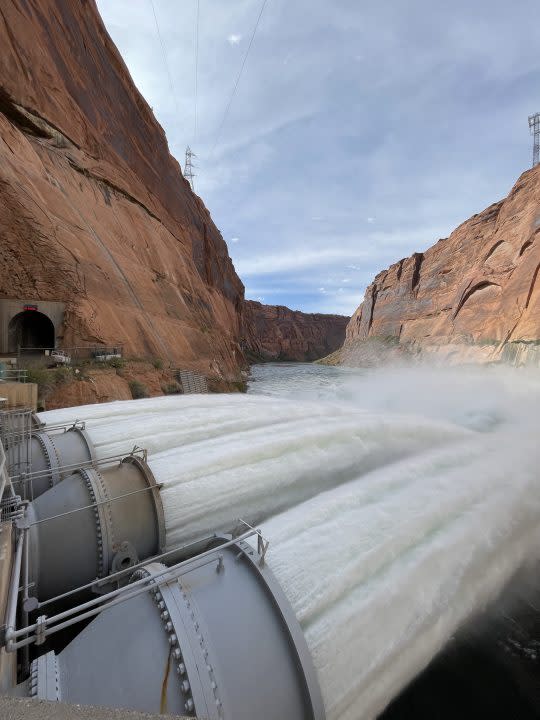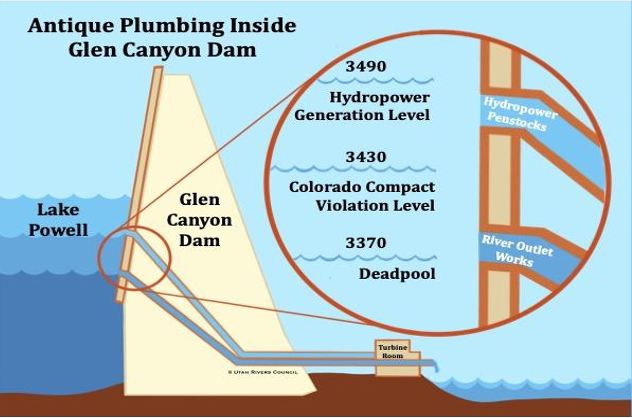Memo reveals damage to pipes inside Glen Canyon Dam, a threat to Colorado River water supply

UPDATE: This article has been updated to add information received Thursday morning from the U.S. Bureau of Reclamation and the Glen Canyon Institute. None of the information in the original article has been changed.
LAS VEGAS (KLAS) — Nearly a year ago, the Colorado River was raging through the Grand Canyon, carrying enough water to raise Lake Mead by an astonishing 2½ feet in just five days.
The surge that began on April 25, 2023, was part of a “High Flow Experiment” release from Glen Canyon Dam, churning up sediment to rebuild beaches and sandbars through the canyon.
But the pipes used to send that gush of water from Lake Powell through Glen Canyon Dam are in trouble, a memo produced by the U.S. Bureau of Reclamation reveals.
“In summary, at reservoir levels below the minimum power pool (elevation 3,490 ft), there are concerns with relying on the river outlet works as the sole means of sustained water releases from Glen Canyon Dam,” the memo said.
The “river outlet works” is a backup system at Glen Canyon, used infrequently because Reclamation needs to generate as much electricity as possible by sending water through the hydropower penstocks, a much larger set of tubes higher up.

A special inspection that happened around last year’s High Flow Experiment found erosion within the four 8-foot pipes of the river outlet works. The evidence of “cavitation” is being described by conservation groups as a new part of the “spectacular water crisis” that demonstrates the magnitude of problems with the dam.
Cavitation produces shock waves that are powerful enough to damage steel, according to David Wegner, who worked 20 years as an engineer for Reclamation. He was lead scientist for environmental impact studies of Glen Canyon Dam, and a founding member of the Glen Canyon Institute. Wegner is now a senior staff member for the U.S. House of Representatives Water Resources and Environment Subcommittee. He is also a member of the National Academy of Sciences Water Science and Technology Board.
Reclamation’s report indicates that using the river outlet works as an everyday part of moving water through the dam is problematic. And that’s bad news, because it’s another strike against a dam that’s already in the crosshairs of environmental groups.
The Reclamation report on how to proceed appears below:
20240326-EstablishmentInterimOperatingGuidanceGlenCanyonDamLowReservoirLevels-TechnicalDecisionMemo-508-TSCDownload
Lake Powell is currently at 3,558 feet (the altitude of the water surface). The critical water level for power generation is 3,490 feet. Reclamation said Lake Powell is expected to be no lower than its current level through February 2026.
Part of the reason is that Reclamation will begin holding more water in Lake Powell at the expense of Lake Mead.
Will Reclamation risk more damage to the system with another High Flow Experiment this year?
“That’s a good question,” Wegner said.
In a response received early Thursday morning, a U.S. Bureau of Reclamation spokesperson told 8 News Now that there will not be a High Flow Experiment release this spring. Plans for fall won’t be set until later this year.
In a memo prepared on March 29, Reclamation officials said, “There is not sufficient sediment to support implementing an HFE at Glen Canyon Dam during the Spring 2024 planning window.” Updates are posted here: https://www.usbr.gov/uc/progact/amp/ltemp.html
“This experiment reveals that the archaic plumbing inside Utah’s Glen Canyon Dam is the most urgent water problem facing the 40 million people of the Colorado River Basin,” according to Zach Frankel, executive director of the Utah Rivers Council.
Frankel and leaders of two other conservation groups publicized findings in August 2022 that Glen Canyon Dam is incapable of meeting water demand if the water’s surface dips below the hydropower penstocks. The river outlet works cannot transport enough water to meet requirements under the Colorado River Compact, a law that dates back a century.

Now, the reliability of those pipes and other infrastructure in the river outlet works is a concern if they ever have to go into daily use.
In an interview with the Arizona Daily Star, Wegner said Reclamation intends to recoat the inside of the pipes with epoxy, which will strengthen them. That’s probably the cheapest solution, he said.
“As an engineer, I will tell you there’s always a solution. The question is the cost, the ability to do it, and the risk of doing it,” Wegner said.
Other options include re-engineering the dam, decommissioning the dam, routing water through bypass tunnels or reducing water consumption so Lake Powell never dips to critical levels.
8 News Now asked Wegner if it’s worth it to fix the dam.
“That depends on who you talk to,” he said. Conservationists will say no, but Reclamation and officials from the seven Colorado River Basin states will dispute that. Water officials from Nevada, Arizona and Colorado stopped short of condemning the dam in preliminary proposals that will guide how Reclamation manages the river. But conservationists and politically powerful California farmers have put a target on the dam.
Kyle Roerink, executive director of the Great Basin Water Network, has criticized Reclamation’s management of the river. “The Bureau has dilly dallied solving Glen Canyon Dam’s plumbing problems long enough,” he said on Wednesday. “This urgent problem needs to be solved ASAP during the current Interim Guideline process.”
Eric Balken, executive director of the Glen Canyon Institute, said, “If we drop everything to solve it, the solution will still take 10 years to implement — so why are we procrastinating?”
In addition to concerns about the pipes, sediment accumulating in Lake Powell presents another problem, Wegner said. Valves, bulkheads and other parts of the aging infrastructure could cause the backup system to fail.
Another factor in whether a High Flow Experiment will happen involves concerns about smallmouth bass that have established a population below the dam. Over the past year, wildlife officials have said that bursts of water could be used to disrupt the “predatory” bass, which pose a threat to native endangered species in the river.
An extremely wet winter last year and another above-average snowpack this year have provided some time for the federal government to work on a solution. Reclamation has prioritized keeping Lake Powell at levels high enough to generate electricity — even borrowing water from Flaming Gorge and Lake Mead to boost water levels at Lake Powell. This year, upstream reservoirs were refilled to guard against a dry year, but snowpack levels remained above-average.
Eric Balken, executive director of the Glen Canyon Institute, provided this statement Thursday morning:
“Even if Reclamation can implement small fixes to the lower outlet tubes in the near term, they will continue to be a problem going forward. They were not designed to operate at low reservoir levels.
“Glen Canyon Dam will be overhauled eventually. It’s a when, not an if. We know that low reservoir levels are the new normal, and we know that the dam is extremely close to becoming a roadblock to water deliveries downstream.
“Given the severity of the water delivery risk, and the time it will take to re-engineer the dam, it needs to be part of planning process now.
“Glen Canyon Dam should be fully bypassed so that it can operate all the way down the original river level, essentially making it a backup flood facility. We should focus on saving Lake Mead, and restoring the Grand Canyon and Glen Canyon.”
For the latest news, weather, sports, and streaming video, head to KLAS.

